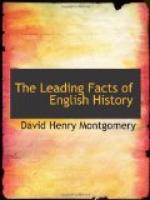“Here lies our sovereign
lord, the King,
Whose word no man relies on;
He never says a foolish thing,
Nor ever does a wise one.”
To which Charles, on reading it, retorted, “’Tis true! because while my words are my own, my acts are my ministers’.”
A bright repartee tells us what the second favorite thought. “Ah! Shaftesbury,” said the King to him one day, “I verily believe you are the wickedest dog in my dominions.” “Yes, your Majesty,” replied Shaftesbury, “for a SUBJECT I think perhaps I may be.”
471. The Clarendon Ministry; Punishment of the Regicides.
From a political point of view, the new reign began decently and ably under the direction of the Earl of Clarendon as leading minister or adviser to the King. The first act of Charles’s first Parliament was to proclaim a pardon to all who had fought against his father in the civil war. The only persons excepted wre the members of that high court of justice (S448) which had sent Charles I to the block. Of these, ten were executed and nineteen imprisoned for life. Most of the other regicide judges were either already out of the country or managed to escape soon after.
Among these, William Goffe, Edward Whalley, and Colonel John Dixwell took refuge in Connecticut, where they remained concealed for several years. Eventually the first two went to Hadley, Massachusetts, where they lived in seclusion in the house of a clergyman until their death.
The bodies of Oliver Cromwell, Ireton, Bradshaw, and Pride, all of whom had served as judges in the trial and condemnation of Charles (S448), were dug up from their graves in Westminster Abbey and hanged in chains at Tyburn.[1] They were then buried at the foot of the gallows along with he moldering remains of highway robbers and criminals of the lowest sort, but Cromwell’s head was cut off and set up on a pinnacle of Westminster Hall.[2]
[1] Tyburn: near the northeast entrance to Hyde Park, London. It was for several centuries the chief place for the public execution of felons. [2] It has since been questioned whether Cromwell’s body was disposed of in this manner or whether another body, supposed at that time to be his, was dealt with as here described. See the “Dictionary of National (British) Biography,” under “Oliver Cromwell.”
472. Religious Persecution; Covenanters; Bunyan.
The first Parliament that met (1661) commanded the common hangman to publicly burn the Solemn League and Covenant (S444); it restored the Episcopal form of worship and enacted four very severe laws, called the “Clarendon Code,” against those Nonconformists or Dissenters who had ejected the Episcopal clergy (S444).[1]
[1] The chief Nonconformists then were: (1) the Presbyterians; (2) the Independents, or Congregationalists; (3) the Baptists; (4) the Society of Friends, or Quakers. Originally the name “Nonconformist” was given to those who refused to conform to the worship of the Church of England, and who attempted to change it to suit their views or else set up their own form of faith as an independent church. The name “Nonconformist” (or Dissenter) now applies to any Protestant outside the Established Church of England (SS496, 498).




